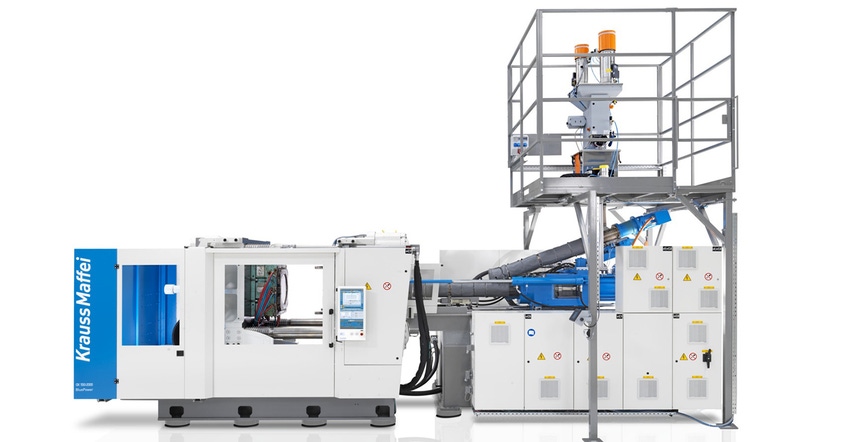Five-piece polyolefin collapsible crates are produced by means of single-screw Direct Compounding Injection Molding.
September 2, 2022

KraussMaffei will be pulling off a triple play of sorts at K 2022 in Düsseldorf, Germany, on Oct. 19 to 26, processing three recycled viscous materials into a new product using single-screw Direct Compounding Injection Molding (DCIM).
|
KraussMaffei will demo its Direct Compounding Injection Molding technology at K 2022 with the production of collapsible crates. |
The demonstration will make five-piece polyolefin collapsible crates in 35 seconds each by combining three recovered materials with disparate melt volume rates (MVR):
Polypropylene staple fiber fleece from masks (MVR 800-1000)
Shredded high-density polyethylene (HDPE) from logistics packaging goods (MVR 5-15)
HDPE blow molding scraps from toy production (MVR < 1)
During the demo, an LRX 350 linear robot will transfer the five parts of each crate from the mold to an automation system that will insert, clip, and stack the crates.
“Blow molding waste is, due to its viscosity, nearly impossible to be processed on standard injection molding machines,” according to Franz-Xaver Keilbach, Global Product and Application Owner Circular Economy and Recycling at KraussMaffei. “With DCIM it is possible. Several customers are looking for such solutions, where they can transfer blow molding waste to injection molding products.”
KraussMaffei’s DCIM technology complements the company’s twin-screw injection molding compounder (IMC). The former allows shot weights from 50 to 2000 grams, while about 1500 grams is required by IMC. The shot weight of the collapsible crate for the K show will be 1000 grams. DCIM is being used worldwide in applications including automotive, packaging/logistics, and technical parts — “all parts where precompounded material is necessary,” Keilbach noted.
The ability of DCIM to create proprietary compounds can save users up to 50% in material costs they might otherwise spend to have compounds developed externally, the company explained.
“In general, the material properties are very close to the original material,” Keilbach said. “We are able to prove that we achieve values very close to original resins. As we do not know original recipes of the virgin suppliers, of course, we can never achieve 100% of the same parameters. Sometimes values are better or a little bit lower. This specific recipe for the K show is a recipe that we created on our own — so, no comparison to virgin material.”
Visit KraussMaffei in hall 15 at booth C24-D24.
About the Author(s)
You May Also Like



